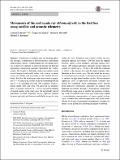Movements of the reef manta ray (Manta alfredi) in the Red Sea using satellite and acoustic telemetry
Author(s)
Skomal, Gregory B.; Thorrold, Simon R.; Berumen, Michael L.; Braun, Camrin Donald
Download227_2015_Article_2760.pdf (1.485Mb)
PUBLISHER_POLICY
Publisher Policy
Article is made available in accordance with the publisher's policy and may be subject to US copyright law. Please refer to the publisher's site for terms of use.
Terms of use
Metadata
Show full item recordAbstract
Populations of mobulid rays are declining globally through a combination of directed fisheries and indirect anthropogenic threats. Understanding the movement ecology of these rays remains an important priority for devising appropriate conservation measures throughout the world’s oceans. We sought to determine manta movements across several temporal and spatial scales with a focus on quantifying site fidelity and seasonality in the northern Farasan Banks, Red Sea. We fitted manta rays with acoustic transmitters (n = 9) and pop-up satellite archival transmitting (PSAT) tags (n = 9), including four with GPS capability (Fastloc), during spring 2011 and 2012. We deployed an extensive array of acoustic receivers (n = 67) to record movements of tagged mantas in the study area. All acoustically tagged individuals traveled frequently among high-use receiver locations and reefs and demonstrated fidelity to specific sites within the array. Estimated and realized satellite tag data indicated regional movements <200 km from the tagging location, largely coastal residency, and high surface occupation. GPS-tagged individuals regularly moved within the coastal reef matrix up to ~70 km to the south but continued to return to the tagging area near the high-occupancy sites identified in the acoustic array. We also tested the accuracy of several geolocation models to determine the best approach to analyze our light-based satellite tag data. We documented significant errors in light-based movement estimates that should be considered when interpreting tracks derived from light-level geolocation, especially for animals with restricted movements through a homogenous temperature field. Despite some error in satellite tag positions, combining results from PSAT and acoustic tags in this study yielded a comprehensive representation of manta spatial ecology across several scales, and such approaches will, in the future, inform the design of appropriate management strategies for manta rays in the Red Sea and tropical regions worldwide.
Date issued
2015-10Department
Joint Program in Oceanography; Woods Hole Oceanographic InstitutionJournal
Marine Biology
Publisher
Springer Berlin Heidelberg
Citation
Braun, Camrin D. et al. “Movements of the Reef Manta Ray (Manta Alfredi) in the Red Sea Using Satellite and Acoustic Telemetry.” Marine Biology 162.12 (2015): n. pag.
Version: Author's final manuscript
ISSN
0025-3162
1432-1793